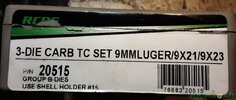Yes, I am curious too.
Perhaps bullet tilting during seating? Differing amount of flare from different resized case lengths? Scraping bullet while applying taper crimp?
Same here.
For calibers that headspace off case mouth, I do not want to chamfer inside of case mouth because you are decreasing the surface area that can "headspace" with the chamber.
NOTE: I also use minimal to no taper crimp so case mouth/neck seal with the chamber faster for less gas leakage.
I have used just enough flare to set the bullet without tiipping/tilting during seating but problem is unless you sort resized cases by length, mixed range brass will produce different resized case length to result different amount of flare. (To address this issue when using mixed range brass, I measure sample of various headstamp brass and use shorter ones to set the flare amount so longer case will apply slightly larger amount of flare

)
As to amount of taper crimp, I just return flare back flat on the bullet. To achieve this, I add average thickness of case wall to the bullet diameter. So for .3555" sized RMR bullet, .3555" + .011" + .011" = ~.378" at case mouth.
And
as requested by their customer base,
Lee Precision addressed these issue FOREVER (No bullet tilt/tipping, no bullet scraping) with stepped "M" powder through expander which,
regardless of resized case length,
eliminated bullet tilt/tipping issue during seating and indexing with inline bullet feeder die (No more fussing with flare amount and different resized case lengths) -
https://www.thehighroad.org/index.p...-through-expander.916523/page-4#post-12725787
If you look at the zoomed in picture of RMR 124 gr FMJ loaded to 1.130" with .378" taper crimp, on the right side of case mouth, you will note sharp right angle of case mouth with gradual taper crimp following "tapered 9mm case" contour with even bulging of case neck at bullet base to show even neck tension -
https://www.thehighroad.org/index.php?threads/thr-group-project-pistol-advanced-reloading-concepts-and-discussions.778197/p(age-10#post-11419509


